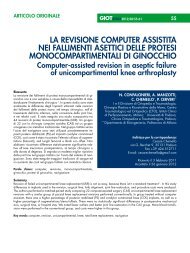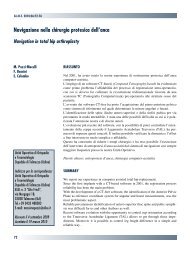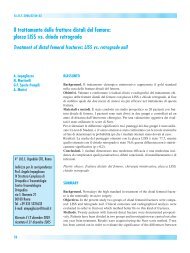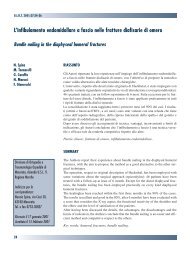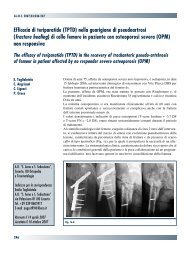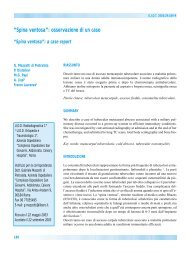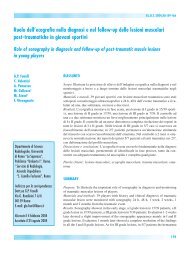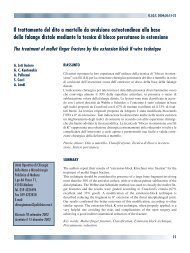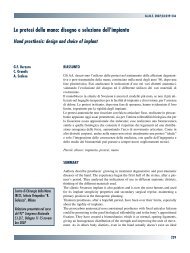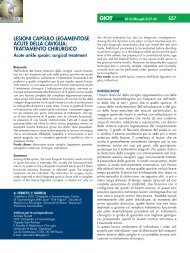Vol.XXXVII, Suppl. 1 - Giornale Italiano di Ortopedia e Traumatologia
Vol.XXXVII, Suppl. 1 - Giornale Italiano di Ortopedia e Traumatologia
Vol.XXXVII, Suppl. 1 - Giornale Italiano di Ortopedia e Traumatologia
You also want an ePaper? Increase the reach of your titles
YUMPU automatically turns print PDFs into web optimized ePapers that Google loves.
s82<br />
vità della popolazione costituisce un aumentato rischio <strong>di</strong><br />
future revisioni dovute a mobilizzazioni asettiche.<br />
Accanto a fattori legati al paziente, le modalità <strong>di</strong> esecuzione<br />
dell’intervento stesso sembrano avere una certa infl<br />
uenza sulla usura degli impianti. Il mal posizionamento,<br />
più frequente negli accessi mininvasivi, o in centri a bassa<br />
frequenza <strong>di</strong> impianti, la persistenza <strong>di</strong> residui ossei <strong>di</strong> cemento<br />
od ematici all’interfaccia delle superfi ci <strong>di</strong> accoppiamenti,<br />
sono concausa <strong>di</strong> eccessiva sovrasollecitazione degli<br />
impianti o <strong>di</strong> micromovimenti che in defi nitiva portano<br />
ad un più rapido degradamento dei materiali. Grande interesse<br />
e stu<strong>di</strong>o è stato de<strong>di</strong>cato alle caratteristiche dell’impianto.<br />
La modularità ha indubbiamente rappresentato un<br />
notevole vantaggio nel ricostituire una più anatomica geometria<br />
articolare, ma i risultati degli impianti <strong>di</strong> prima generazione<br />
ha determinato un netto cambiamento <strong>di</strong> rotta,<br />
portando al ritiro degli accoppiamenti collo-stelo in titanio<br />
con i migliori impianti in Co-Cr29-Mo che al momento, ad<br />
uno short term follow-up non sembrerebbero evidenziare<br />
complicanze degne <strong>di</strong> nota. Un altro campo <strong>di</strong> grande interesse<br />
è quello legato agli impianti <strong>di</strong> grande <strong>di</strong>ametro.<br />
I notevoli progressi, a partire dagli anni 2000, in campo<br />
tribologico hanno permesso <strong>di</strong> utilizzare teste protesiche <strong>di</strong><br />
sempre maggiori <strong>di</strong>mensioni. Gli indubbi vantaggi sono<br />
rappresentati da una maggiore stabilità, un minor rischio <strong>di</strong><br />
lussazione e una maggiore escursione articolare, con conseguente<br />
migliore performance sulla motilità e con maggiore<br />
sod<strong>di</strong>sfazione del paziente. Inoltre, e si deve ammettere,<br />
i gran<strong>di</strong> <strong>di</strong>ametri evidenziano scarse complicanze anche<br />
in caso <strong>di</strong> lievi mal posizionamenti dell’impianto da parte<br />
del chirurgo. Sebbene le teste <strong>di</strong> grande <strong>di</strong>ametro abbiano<br />
ampiamente superato i preliminari test sperimentali (simulatori)<br />
e clinici (a breve termine) luci ed ombre persistono<br />
riguardo l’assenza <strong>di</strong> complicanze a lungo termine, ed una<br />
certa cautela è tuttora raccomandata nel loro impianto.<br />
Bibliografi a<br />
1 Goodman SB, Wright T. 2007 AAOS/NIH<br />
osteolysis and implant wear: biological,<br />
biome<strong>di</strong>cal engineering, and surgical principles.<br />
Introduction. J Am Acad Orthop Surg<br />
2008;16(<strong>Suppl</strong> 1):x-xi.<br />
2 Agency for Healthcare Research and Quality:<br />
Healthcare Cost & Utilization Project<br />
(HCUP). Rockville, MD: US Department of<br />
Health and Human Services. www.ah cpr.<br />
gov/data/hcup.<br />
3 Kurtz S, Ong K, Lau E, et al. Projections of primary<br />
and revision hip and knee arthroplasty<br />
in the United States from 2005 to 2030. J<br />
Bone Joint Surg Am 2007;89:780-5.<br />
4 Dumbleton JH, Manley MT, E<strong>di</strong><strong>di</strong>n AA. A<br />
literature review of the association between<br />
wear rate and osteolysis in total hip arthroplasty.<br />
J Arthroplasty 2002;17:649-61.<br />
g. Logroscino Et aL<br />
5 Schmalzried TP, Jasty M, Harris WH.<br />
Periprosthetic bone loss in total hip arthroplasty:<br />
Polyethylene wear debris and the<br />
concept of the effective joint space. J Bone<br />
Joint Surg 1992;74:849-63.<br />
6 Heisel C, Silva M, Schmalzried TP. In vivo<br />
wear of bilateral total hip replacements: Conventional<br />
versus crosslinked polyethylene.<br />
Arch Orthop Trauma Surg 2005;125:555-7.<br />
7 Leung SB, Egawa H, Stepniewski A, et al.<br />
Incidence and volume of pelvic osteolysis at<br />
early follow-up with highly cross-linked and<br />
noncross-linked polyethylene. J Arthroplasty<br />
2007;22(<strong>Suppl</strong> 2):134-9.<br />
8 Marshall A, Ries MD, Paprosky W. How<br />
prevalent is implant wear and osteolysis,<br />
and how has the scope of osteolysis<br />
changed since 2000? J Am Acad Orthop<br />
Surg 2008;16(<strong>Suppl</strong> 1):S1-6.<br />
Riguardo gli accoppiamenti, la ceramica-ceramica è particolarmente<br />
in<strong>di</strong>cata in pazienti giovani e attivi, per l’elevata<br />
resistenza all’usura e perché produce scarsa quantità<br />
<strong>di</strong> detriti poco attivi biologicamente. Gli svantaggio <strong>di</strong><br />
questo accoppiamento sono un teorico rischio <strong>di</strong> frattura,<br />
<strong>di</strong> squeaking e un basso numero <strong>di</strong> misure <strong>di</strong> testine <strong>di</strong>sponibili<br />
sul mercato. L’accoppiamento ceramica-polietilene<br />
presenta una maggiore resistenza all’usura rispetto<br />
all’accoppiamento metallo-polietilene. L’accoppiamento<br />
ceramica-polietilene reticolato ha una particolare resistenza<br />
all’usura, specialmente in presenza <strong>di</strong> particelle da<br />
terzo corpo. La recente introduzione <strong>di</strong> allumina tenacizzata<br />
con zirconia presenta una maggiore resistenza alla<br />
rottura dell’allumina e una maggiore gamma <strong>di</strong> numeri<br />
e offset. In laboratorio l’Oxinium accoppiato al polietilene<br />
e la ceramica-metallo hanno <strong>di</strong>mostrato elevata resistenza<br />
all’usura, ma mancano stu<strong>di</strong> clinici con suffi cienti<br />
follow-up per <strong>di</strong>mostrare se il loro comportamento in vivo<br />
presenta effettivi vantaggi rispetto al metallo-polietilene,<br />
metallo-metallo e ceramica-ceramica.<br />
concLusioni<br />
La tribologia costituisce una scienza in continuo aggiornamento,<br />
a cui suo malgrado il chirurgo non può che<br />
adeguarsi, cautelando se stesso ed il paziente stesso da<br />
innovazioni, che a volte hanno determinato clamorosi fallimenti<br />
nel tempo, ma a cui dati i più recenti risultati non<br />
si può fare a meno <strong>di</strong> adeguarsi al fi ne <strong>di</strong> arginare il tasso<br />
<strong>di</strong> revisioni previste a me<strong>di</strong>o lungo termine. Le sempre più<br />
crescenti esigenze funzionali dei pazienti costituiscono un<br />
maggiore rischio <strong>di</strong> usura a cui solo una crescente attenzione<br />
e sforzo da parte della ricerca e degli stu<strong>di</strong> clinici<br />
potrà dare un’adeguata risposta per ridurre il tasso <strong>di</strong> fallimenti<br />
futuri delle protesi impiantate nel passato o peggio<br />
ancora nel presente.<br />
9 McKellop HA. The lexicon of polyethylene<br />
wear in artifi cial joints. Biomaterials<br />
2007;28:5049-57.<br />
10 Foran JR,Mont MA, Etienne G, et al. The outcome<br />
of total knee arthroplasty in obese patients.<br />
J Bone Joint Surg Am 2004;86:1609-<br />
15.<br />
11 Foran JR, Mont MA, Rajadhyaksha AD, et al.<br />
Total knee arthroplasty in obese patients: A<br />
comparison with a matched control group. J<br />
Arthroplasty 2004;19:817-24.<br />
12 McClung CD, Zahiri CA, Higa JK, et al.<br />
Relationship between body mass index and<br />
activity in hip or knee arthroplasty patients. J<br />
Orthop Res 2000;18:35-9.<br />
13 Lavernia CJ, Sierra RJ, Hungerford DS, et al.<br />
Activity level and wear in total knee arthroplasty:<br />
A study of autopsy retrieved specimens.<br />
J Arthroplasty 2001;16:446-53.



